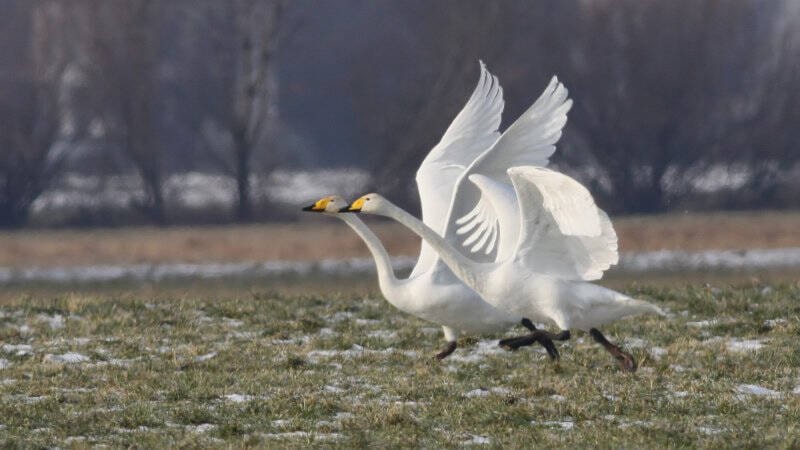Thousands of migrating swans and other waterfowl will stop over in the Yukon’s Southern Lakes this spring. One bird in their midst is unique and far from home.
A whooper swan, a bird whose native summer range could be the Kamchatka Peninsula in far eastern Russia, was spotted April 7, among the other migrating swans at M’Clintock Bay on Marsh Lake.
The sighting is rare; this is only the fourth time a whooper swan has been recorded in the Yukon.
Cameron Eckhart, the executive director of the Yukon Bird Club, said past spring migration whooper swan sightings have been recorded at M’Clintock Bay in 2003 and Teslin Lake in 2005. One of the Eurasian birds was also spotted on Herschel Island on the Yukon’s northern coast in the summer of 2006. He said this is the first confirmed whooper swan sighting in the territory in about 15 years.
The lone adult bird may have been the same one that was also spotted on the west coast of the United States and then in British Columbia for the province’s first whooper swan sighting ever earlier this year.
While similar in size and shape to the trumpeter swans that are on their northerly migration through the Yukon, the whooper swan has a bright yellow bill that distinguishes it from its travelling companions.
Eckhart said the bird spent two days resting and feeding at the bay near the Swan Haven Interpretive Centre.
Where's Whooper?! Whoops of excitement echoed across Marsh Lake yesterday and today as birders picked out a spectacular Whooper Swan among hundreds of its Trumpeter cousins at Swan Haven! A rare visitor from Asia. Thanks Adam Perrier for the photo... pic.twitter.com/nA5gWiBZwZ
— Yukon Birds (@YukonBirds) April 9, 2022
The unique swan was initially spotted by Jukka Jantunen, who works counting the birds making a stop in the Southern Lakes.
Jantunen is familiar with whooper swans; they are the national bird of his native Finland and he has spotted two of the ones that have stopped off in the Yukon over the past 20 years. Despite his familiarity, he said he felt an adrenaline rush upon seeing the whooper’s head and distinctive yellow bill surface from the lake.
“It’s exciting. Rare birds are always exciting,” Jantunen said.
Jantunen quickly shared the news of the rare bird he spotted, allowing others a chance to get a look at it before it continued north. He said that with the exception of vulnerable nesting birds he is always happy to share the locations of rare birds he spots so people can get a look for themselves.
Jantunen said in his experience, the Yukon has a very good and respectful birding community that he doesn’t worry about disturbing the birds he publishes the locations of.
He said there is some friendly competition among birders building up their “life lists” or the total number of species they have seen. Some people got to add whooper swan to their list as Eckhart said some online posts about the whooper swan led to a small influx of birders.

The whooper swan is no longer in the M’Clintock Bay area and questions remain as to how it got to North America and where it is going now.
Jantunen said it is more common for migratory birds to go astray as juveniles and so the swan might have gone off course years ago and continued to follow the trumpeter swans around into its adulthood. He said a “spring overshoot” of the bird’s planned migration destination into Alaska, likely caused by weather patterns, is also a possibility. He noted the whooper swans are sometimes seen on the Aleutian Islands at the far western tip of Alaska.
Once a bird has gone severely off course on its migration, Jantunen said it will often fall in with the most similar birds it can find. Eckhart said the whooper swans seen in the Southern Lakes region have always been travelling with the trumpeter swans in this way.
Along with the swans Jantunen said birders in the southern Yukon will be treated to migrations of other waterfowl, shore birds and songbirds in the coming weeks.
Contact Jim Elliot at jim.elliot@yukon-news.com
